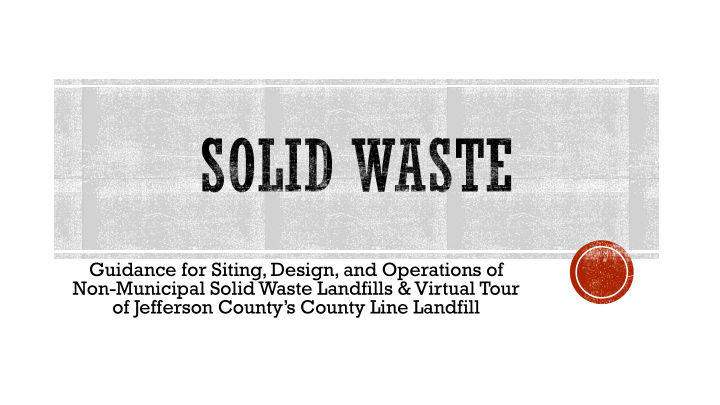



Guidance for Siting, Design, and Operations of Non-Municipal Solid Waste Landfills & Virtual Tour of Jefferson County’s County Line Landfill
1- Bonneville County Transfer Station 10-Madision County NMSW Landfill 2- Clark County C&D 11- Madison County Transfer Station 3- Jefferson’s County Line NMSWF 12- Physicians Professional Services 4- Custer County C&D 13- Pure Sterilization 5- Fremont County Transfer Station 14- St. Clair Pit 6- Golden Valley NMSW Landfill 15- Teton County NMSW Landfill 7- Hatch Pit 16- Teton County Transfer Station 8- Hitt Pit 17- Tower Pit 9- Mackay C&D
In addition to municipal wastes, the disposal of other wastes in a NMSWLF is prohibited. These wastes include, but are not limited to, the following: Carpet (from households, motels, hotels, bunkhouses, ranger stations, and crew quarters) Electronic waste Furniture (from households, motels, hotels, bunkhouses, ranger stations, and crew quarters) Hazardous waste (e.g., batteries, paint, solvents, lead, and mercury) Household waste (including clothing, toys, and household hazardous waste) Untreated medical/healthcare wastes (regulated medical waste must be decontaminated asdefined in 29 CFR 1910.1030) Petroleum or petroleum-based products (e.g., oil, caulking, adhesives, epoxies, petroleum-contaminated soils) Pesticides/herbicides/insecticides Tires — Tires may be accepted for off-site recycling or off-site disposal Unopened or opaque garbage bags (unable to identify contents) Treated wood, especially wood treated with creosote, pentachlorophenol, or copperchrome- arsenate (e.g., fencing, decking, utility poles, and freshwater pilings) Yard waste (from households, motels, hotels, bunkhouses, ranger stations, and crewquarters)
Petroleum or petroleum-based products- Special effort should be made to ensure that chemical containers such as paint cans, adhesive buckets, fuel containers, and pesticide containers are not accepted for disposal. Containers are the concern here. DEQ is restricting both empty and partially empty containers. These waste products should be restricted or pulled out by site staff. Yard waste- Weeds, straw, leaves, grass clippings, brush, wood, and other natural, organic, materials typically derived from general landscape maintenance activities (IDAPA 58.01.06). Facilities can compost on site (green waste or mortality) if yard wastes are separated and located by the compost location. As long as composting is addressed in the operation plan. EDUCATION OF BOTH THE PUBLIC AND STAFF WILL BE REQUIRED TO AVOID VIOLATIONS
Carpet Furniture Plastic Highchair
Office Equipment While not a violation, Cardboard should be recycled to save landfill space Electronics
NUISANCE CONTROL- All owner and operators of NMSWLFs must control for nuisances. Nuisance issues are one of the public’s concerns surrounding a landfill site. Odor; vectors, such as flies and rodents; and blowing litter are a few of the nuisance conditions that can occur at a landfill. Effectively managing incoming waste can help reduce nuisance issues. Adequate periodic cover, litter control fences, and effective vector control are a few actions that landfill owners and operators can implement to reduce nuisance conditions. OPEN BURNING- All NMSWLFs may conduct open burning only if they first request permission of the DEQ and notify the local fire department. Infrequent open burning of agricultural wastes, silvicultural waste, land-clearing debris, diseased trees, or debris from emergency cleanup operations is the only open burning allowed.
Periodic cover applied over disposed waste serves several purposes. Cover reduces blowing litter, controls odor, limits vector access to waste, reduces the potential for fires, and reduces the potential of leachate generation. 40 CFR Part 257.3-8(e )(6) defines periodic application of cover material to mean “the application and compaction of soil or other suitable material over disposed solid waste at the end of each operating day or at such frequencies and in such a manner as to reduce the risk of fire and to impede disease vectors’ access to the waste .” The operating plan must provide a specific frequency (e.g., at the end of each operating day, every 3 days, every 5 days, or every 2 weeks). Statements such as, “periodic cover will be applied as needed to prevent nuisance and vector conditions” should not be included in operating plans. These types of statements provide no objective standard for determining when and/or if these conditions exist or who will make this determination. Written justification is needed for reduced cover frequency.
Tier II and Tier II landfills are required to provide interim cover. Interim cover is the application of 12 inches of compacted soil placed over areas of waste that will not receive additional waste for an extended period of time or in between lifts to provide structural stability. The time frame for considering interim cover application is typically 3 – 6 months, depending on the time of the year. Not only does interim cover provide additional protection against precipitation leaching through the waste, but, if properly sloped, precipitation running off interim cover can be managed as stormwater rather than leachate from periodic cover.
Recommend
More recommend